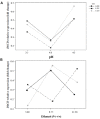A Response Surface Methodology Approach to Investigate the Effect of Sulfur Dioxide, pH, and Ethanol on DbCD and DbVPR Gene Expression and on the Volatile Phenol Production in Dekkera/Brettanomyces bruxellensis CBS2499
- PMID: 28955312
- PMCID: PMC5601905
- DOI: 10.3389/fmicb.2017.01727
A Response Surface Methodology Approach to Investigate the Effect of Sulfur Dioxide, pH, and Ethanol on DbCD and DbVPR Gene Expression and on the Volatile Phenol Production in Dekkera/Brettanomyces bruxellensis CBS2499
Abstract
Dekkera/Brettanomyces bruxellensis, the main spoilage yeast in barrel-aged wine, metabolize hydroxycinnamic acids into off-flavors, namely ethylphenols. Recently, both the enzymes involved in this transformation, the cinnamate decarboxylase (DbCD) and the vinylphenol reductase (DbVPR), have been identified. To counteract microbial proliferation in wine, sulfur dioxide (SO2) is used commonly to stabilize the final product, but limiting its use is advised to preserve human health and boost sustainability in winemaking. In the present study, the influence of SO2 was investigated in relation with pH and ethanol factors on the expression of DbCD and DbVPR genes and volatile phenol production in D. bruxellensis CBS2499 strain under different model wines throughout a response surface methodology (RSM). In order to ensure an exact quantification of DbCD and DbVPR expression, an appropriate housekeeping gene was sought among DbPDC, DbALD, DbEF, DbACT, and DbTUB genes by GeNorm and Normfinder algorithms. The latter gene showed the highest expression stability and it was chosen as the reference housekeeping gene in qPCR assays. Even though SO2 could not be commented as main factor because of its statistical irrelevance on the response of DbCD gene, linear interactions with pH and ethanol concurred to define a significant effect (p < 0.05) on its expression. The DbCD gene was generally downregulated respect to a permissive growth condition (0 mg/L mol. SO2, pH 4.5 and 5% v/v ethanol); the combination of the factor levels that maximizes its expression (0.83-fold change) was calculated at 0.25 mg/L mol. SO2, pH 4.5 and 12.5% (v/v) ethanol. On the contrary, DbVPR expression was not influenced by main factors or by their interactions; however, its expression is maximized (1.80-fold change) at the same conditions calculated for DbCD gene. While no linear interaction between factors influenced the off-flavor synthesis, ethanol and pH produced a significant effect as individual factors. The obtained results can be useful to improve the SO2 management at the grape harvesting and during winemaking in order to minimize the D./B. bruxellensis spoilage.
Keywords: D./B. bruxellensis; cinnamate decarboxylase gene; gene expression; response surface methodology; vinylphenol reductase gene; volatile phenols.
Figures



 ), 0 mg/L mol. SO2; long-dashed line (
), 0 mg/L mol. SO2; long-dashed line ( ), 0.125 mg/L mol. SO2; short-dashed line (
), 0.125 mg/L mol. SO2; short-dashed line ( ), 0.25 mg/L mol. SO2.
), 0.25 mg/L mol. SO2.Similar articles
-
Relation between coumarate decarboxylase and vinylphenol reductase activity with regard to the production of volatile phenols by native Dekkera bruxellensis strains under 'wine-like' conditions.Int J Food Microbiol. 2015 Aug 3;206:51-5. doi: 10.1016/j.ijfoodmicro.2015.04.023. Epub 2015 Apr 23. Int J Food Microbiol. 2015. PMID: 25955288
-
Interactive effects between total SO2 , ethanol and storage temperature against Brettanomyces bruxellensis.Lett Appl Microbiol. 2018 Jan;66(1):71-76. doi: 10.1111/lam.12816. Epub 2017 Dec 6. Lett Appl Microbiol. 2018. PMID: 29080348
-
Wine Spoilage Control: Impact of Saccharomycin on Brettanomyces bruxellensis and Its Conjugated Effect with Sulfur Dioxide.Microorganisms. 2021 Dec 7;9(12):2528. doi: 10.3390/microorganisms9122528. Microorganisms. 2021. PMID: 34946131 Free PMC article.
-
Starter cultures as biocontrol strategy to prevent Brettanomyces bruxellensis proliferation in wine.Appl Microbiol Biotechnol. 2018 Jan;102(2):569-576. doi: 10.1007/s00253-017-8666-x. Epub 2017 Nov 30. Appl Microbiol Biotechnol. 2018. PMID: 29189899 Free PMC article. Review.
-
Brettanomyces bruxellensis yeasts: impact on wine and winemaking.World J Microbiol Biotechnol. 2017 Sep 21;33(10):180. doi: 10.1007/s11274-017-2345-z. World J Microbiol Biotechnol. 2017. PMID: 28936776 Review.
Cited by
-
Flocculation Mechanisms in Brettanomyces bruxellensis: Influence of ethanol and sulfur dioxide on FLO gene expression.Curr Res Microb Sci. 2025 Mar 7;8:100372. doi: 10.1016/j.crmicr.2025.100372. eCollection 2025. Curr Res Microb Sci. 2025. PMID: 40207139 Free PMC article.
-
Occurrence of Brettanomyces bruxellensis on Grape Berries and in Related Winemaking Cellar.Front Microbiol. 2019 Mar 7;10:415. doi: 10.3389/fmicb.2019.00415. eCollection 2019. Front Microbiol. 2019. PMID: 30899251 Free PMC article.
References
-
- Benito S., Palomero F., Morata A., Calderòn F., Suàrez-Lepe J. A. (2009). Factors affecting the hydroxycinnamate decarboxylase/vinylphenol reductase activity of Dekkera/Brettanomyces: application for Dekkera/Brettanomyces control in red wine making. J. Food Sci. 74 M15–M22. 10.1111/j.1750-3841.2008.00977.x - DOI - PubMed
-
- Chandra M., Barata A., Ferreira-Dias S., Malfeito-Ferreira M., Loureiro V. (2014). A response surface methodology study on the role of factors affecting growth and volatile phenol production by Brettanomyces bruxellensis ISA 2211 in wine. Food Microbiol. 42 40–46. 10.1016/j.fm.2014.03.002 - DOI - PubMed
LinkOut - more resources
Full Text Sources
Other Literature Sources

